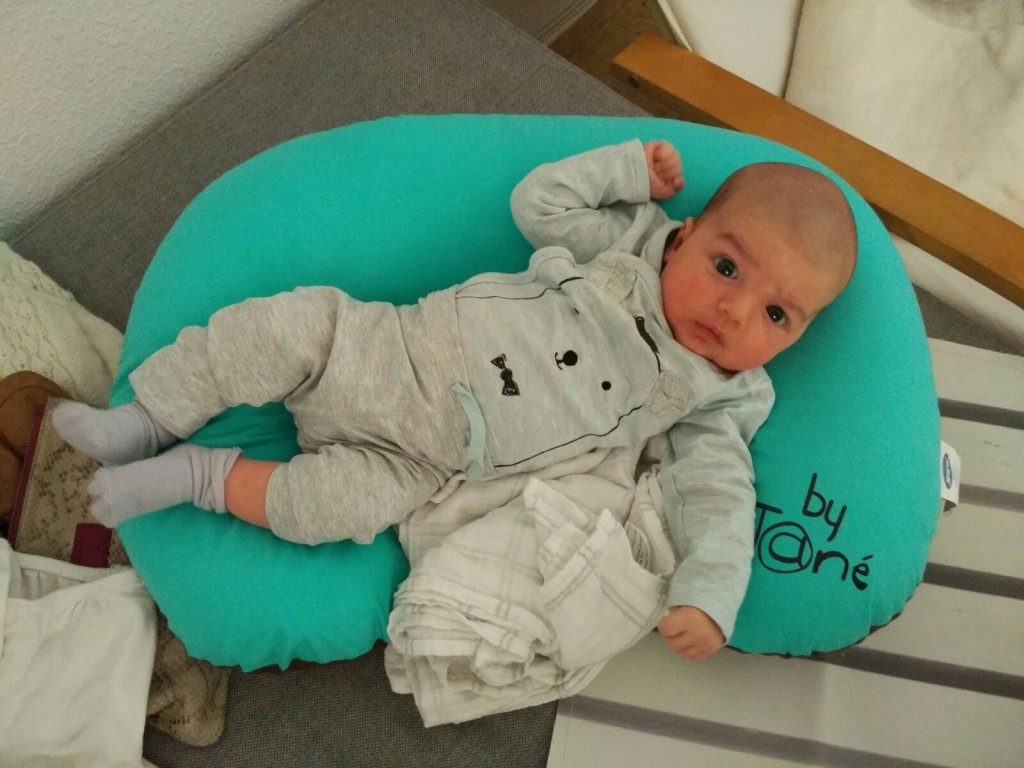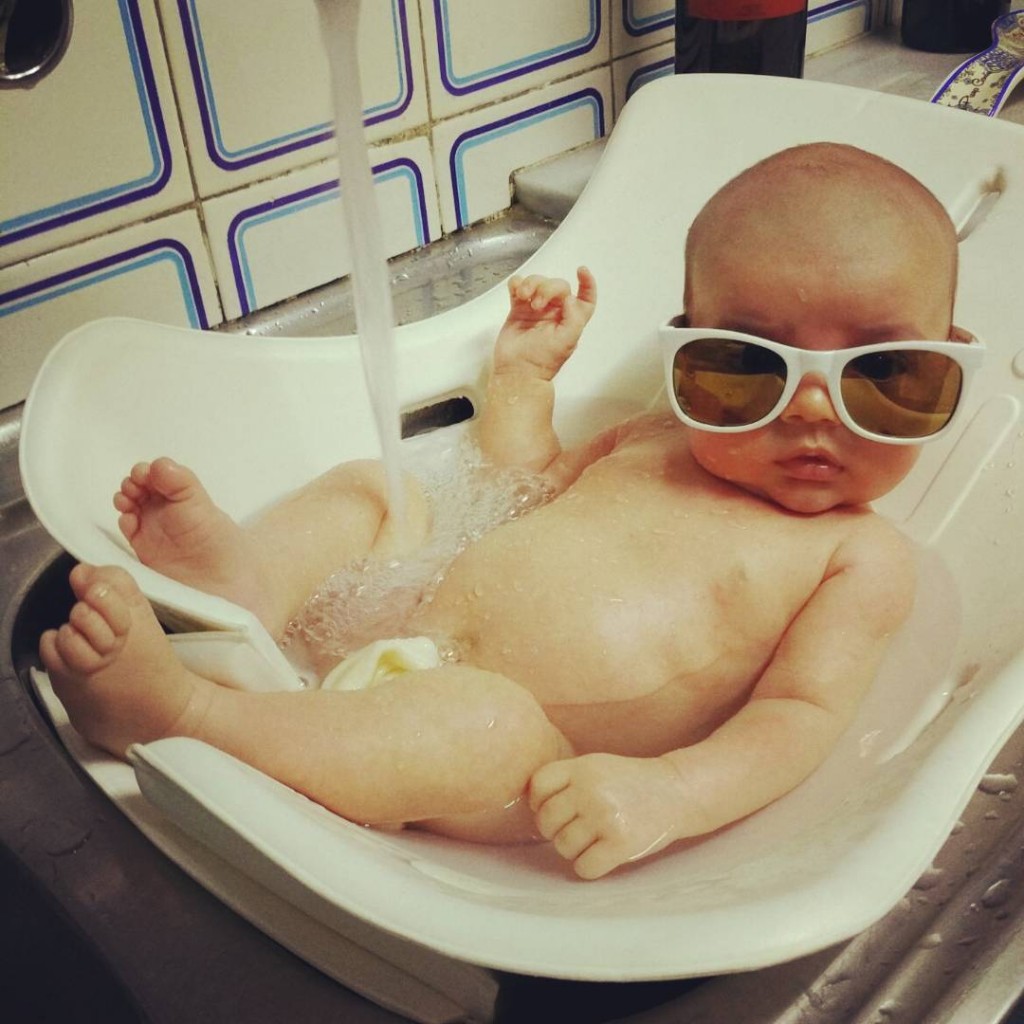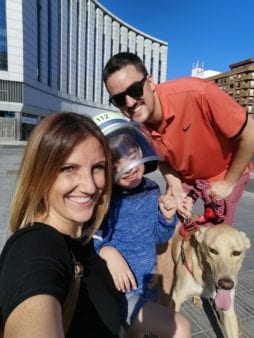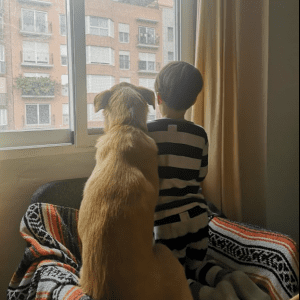Moms are always wondering what they really need for their new baby. We often register for all the shiniest new toys and gadgets and end up using the three things that were handed down to us from a more experienced mama. It is difficult not to buy everything. We want to feel prepared. We want our baby to be happy and well taken care of. We want to head into motherhood ahead of the game and ready for anything.
With that said, here are my recommendations for the 10 must-have products for a new mom. These are the things that were crucial during Luca’s first three months. They helped keep mom and dad sane and kept baby happy during “the fourth trimester“.
1. A nursing pillow
The most common nursing pillow in the states is the “Boppy“. If you are pregnant with your second child, I’d recommend “My Brest Friend“, which buckles around your waist, allowing you to be somewhat hands-free (even while nursing). Our Jané nursing pillow served a multitude of purposes. First, it was the only way I could “sit” postpartum. Secondly, it was where Luca took most of his naps. Many babies sleep more comfortably when they are propped at an angle as it reduces acid reflux and colic. Lastly, more obviously, I used my nursing pillow for breastfeeding.
2. A Baby carrier
Baby wearing helps to stimulate a baby’s nervous system, enhance bonding between parent and child, reduce crying and allows you to be hands-free! Some mornings, wearing Luca was the only way I was able to eat a proper breakfast and using a baby carrier allowed Timi and I to enjoy some quiet lunch dates early on during the first months postpartum.
One of my favorite baby carrier brands during the first 3 months was the “Happy Wrap“. This wrap, made with super-soft organic bamboo, is so lightweight and packs incredibly small so it was easy to keep in our diaper bag (or purse!) for use on demand.
Our Ergobaby carrier was a lifesaver as well. Especially when we traveled internationally with Luca when he was 7 weeks old and 12 weeks old. This carrier is supportive and ergonomically correct so we felt confident carrying Luca for long periods of time when needed.
3. Doona carseat stroller
The Doona is a one-of-a-kind, innovative, and absolutely amazing product! Its compact size is incredibly convenient to use on public transport and as we navigate small stores and coffee shops in the city. This stroller collapses in on itself, becoming the carseat. We didn’t need to worry about loading a extra base in the car or lugging a heavy carseat up to our flat. Having the wheels attached to the stroller allowed me to easily transfer the carseat in and out of the car by myself.
4. Swaddle
Swaddling helped Luca to fall asleep quicker and stay asleep longer. As swaddling reduces the Moro reflex for newborns, he did not wake himself up with flailing arms, nor could he accidently scratch himself as he slept. He feels cozy and secure as he sleeps. This was a big help during the winter as swaddling allowed him to sleep wrapped in a blanket, but without the fear of the blanket moving over his face during the night.
Our favorite swaddles: the Halo SleepSack Swaddle and the Ollie World swaddle.

5. Pacifier
We tried. We really did. I had a goal to not give Luca a pacifier for the first month. We lasted 10 days. It ended up being a game changer. I really wanted to listen to him, learn his cues and various cries, and provide a solution for his crying as soon as possible. A pacifier is often used to delay a response and can even be used to suppress hunger. After realizing there were legitimate times that we needed to delay a feed or encourage sleep, we gave in. Because we only use the pacifier when Luca is going to sleep or when he’s in his carseat or stroller, it has helped to develop sleep cues for him, which has in turn, helped us tremendously.
Our favorite pacifier: Natursutten natural, toxin-free pure rubber pacifier
6. Sleeping gowns
Newborns poop. A lot. In the middle of the night, the last thing you want to do is have to remove your baby’s pajamas completely, in order to change them… multiple times. Both swaddles mentioned above open from the bottom, which allow baby to stay wrapped during diaper changes. Dressing Luca in sleeping gowns, which also open from the bottom, was incredibly convenient. It allowed him to stay warm and remain drowsy as we quickly changed him during the night. The organic cotton gowns from L’oved Baby were my favorite during the first three months.
7. Nose sucker
Take your pick. Yes. Pun intended. The NoseFrida is popular in the US. In Spain, we use the Rhinomer baby “aspirador nasal“. Either way, you are going to end up wanting one of these on hand. When your baby has his first signs of congestion, you aren’t going to want to get in the car and head to pharmacy to buy your first booger buster. These tools are great, natural ways to remove mucus and boogers from your little one’s nose and help them to breathe (and sleep) better. They also work well with an infant saline spray.
8. Puj tub
This foldable baby bathtub fits in the kitchen sink and hangs flat to dry! It is made of a super soft foam, which is nice and comfortable for newborns. Luca loves bath time and I think it’s partly due to the fact that he loves his Puj Tub!
9. Coconut oil
I’m not a big fan of lotions and soaps for myself and only want to use the most natural solutions for my infant as well. We have jars of coconut oil all over the house and use it for everything! We use it in place of a barrier cream during diaper changes, to help soothe dry skin and cradle cap, for our nightly baby massage, and I also used it on myself during the first weeks of breastfeeding. I suggest buying food-grade, organic, extra virgin coconut oil. You can find this at your local Trader Joes or Sprouts. Live in Spain? You can buy coconut oil in Spain at pretty much any local, health food store. I buy mine from Herbolario Navarro and Ecorganic Market. Coconut oil is safe for babies to consume and it can help to improve babies’ immune system and digestion.
Read 20 Ways to Use Coconut Oil on Infants and Children
10. Lactation consultant
A lactation consultant. This is less of a product, more of a necessity. I tell all new moms not to pass on lactation consulting. The first 48 hours are crucial for implementing effective breastfeeding practices and stimulating milk production. In addition, the first 48 hours postpartum are often a complete blur. The last thing you may be thinking about is going to a class to learn about breastfeeding. That is why I recommend hiring a personal lactation consultant who will work with you one-on-one a few times a day in your hospital room. I would also encourage your partner to be present during the consultations. I was a mess postpartum and purely focused on my own healing and bonding with Luca. If it wasn’t for Timi learning the lactation techniques alongside me, and helping to position Luca properly the following weeks, I am not sure I would have been able to successfully breastfeed. If you aren’t able to hire a personal lactation consultant, check with your hospital to see what lactation services they provide during your stay as well as during the first weeks and months after delivery.
Live in Valencia, Spain? I highly recommend our lactation consultant, Palomade Miguel. Find her here on Facebook.







